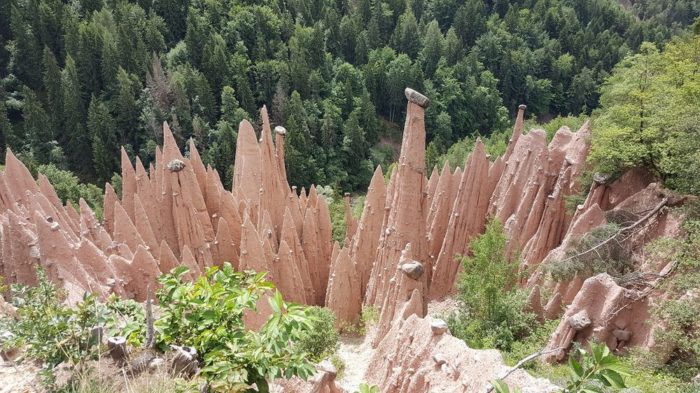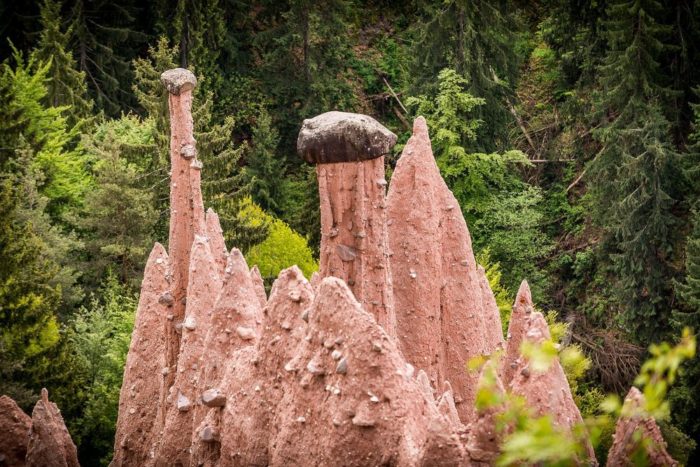Earth pyramids
Ever hear of earth pyramids? I hadn’t.
I thought it was some sort of spoof when I first saw these photos. Maybe an old April Fools’ prank? But they are real:
At many places across South Tyrol, in northern Italy, one can see a peculiar geological formation called “earth pyramids”. They consist of tall cone-shaped pillars made of clay, with a boulder resting on top.
These unusual structures started forming from moraine clay soil left behind after the last Ice Age when the glaciers melted away. In dry condition the soil is hard as stone, but as soon as it rains, it turns into a soft muddy mass, starts sliding, and forms large slopes 10 to 15 meters steep. When the rainy season starts, these slopes erode away. But when there are rocks in the mud, the clay soil underneath these rocks stays protected from the rain. So, while the surrounding material is continually carried off with the rain, the protected pillars rise out of the ground to form majestic earth pyramids. It can take hundreds to thousands of years for these pyramids to form.
Why are these not exceptionally famous the world over? Well, somebody’s heard of them, because they have their own Trip Advisor page.



I certainly hadn’t heard of them either. One more example of the essential truth in Shakespeare’s line in Hamlet; “There are more things in heaven and earth, Horatio, Than are dreamt of in your philosophy.”
There may be nothing new under the sun but there’s no end to new discoveries waiting to be found.
Reminds me of the hoodoos a bit north of here, in the southwest US. Some have large dinosaur bones poking out.
Here be dragons.
If memory serves, and sometimes it doesn’t, I’ve seen photos of similar stuff in the southwestern U.S. I think neal is correct. Pretty cool though.
“A hoodoo (also called a tent rock, fairy chimney, and earth pyramid) is a tall, thin spire of rock that protrudes from the bottom of an arid drainage basin or badland.”
The Hoodoos look similar to earth pyramids but are formed by alternate freezing and thawing cycles.
https://en.wikipedia.org/wiki/Hoodoo_(geology)
Geology is a fascinating subject. Many facets to it and many still unsolved problems. So many amazing things that the elements have created over long periods of time. It requires the ability to understand forces that work over eons. Not easy to do when our life spans are so short.
J.J.
There are also hoodoos near Crater Lake National Park in volcaniclastics.
http://www.americansouthwest.net/oregon/crater-lake/pinnacles-trail.html
Formed by different process than at Bryce Canyon or in the Badlands appearantly.
Neo,
Check out Bryce Canyon National Park sometime if you haven’t been. The shapes are different from the ones you show here, but I remember being awed by how bizarre the whole place looked.
om, that’s interesting. Did not know about those.
Apparently formed by volcanic gas hardening the rocks that became the pinnacles.
From your link:
“The formations rise up in the ravine below, formed of conglomerate-type rocks – compressed pumice and ash from long ago volcanic eruptions. Once when these rocks formed a thick, unbroken layer, hot gases escaping from below created long, narrow holes (fumaroles) surrounded by a heat-hardened lining, now left exposed as the softer deposits have eroded away.”
Sounds plausible and has undoubtedly been studied in some detail.
J.J.
Visited the area on a Geology of Oregon field trip long ago in grad school. Had to Google to find the location as I could never locate my photos from that trip nor remember the specific location. I remembered what they looked like and that they were in volcaniclastics. Technology sometimes is a good thing?
“Hoodoos” can also be found in central Alberta (Drumheller and along the Red Deer River) and western Alberta (just east of Banff on the Trans-Canada Highway), as well as in B.C. (Fairmont, Radium area, along the Columbia River, if I recall correctly), but I believe that these are caused merely by erosion (wind and rain).
Not an expert, though.